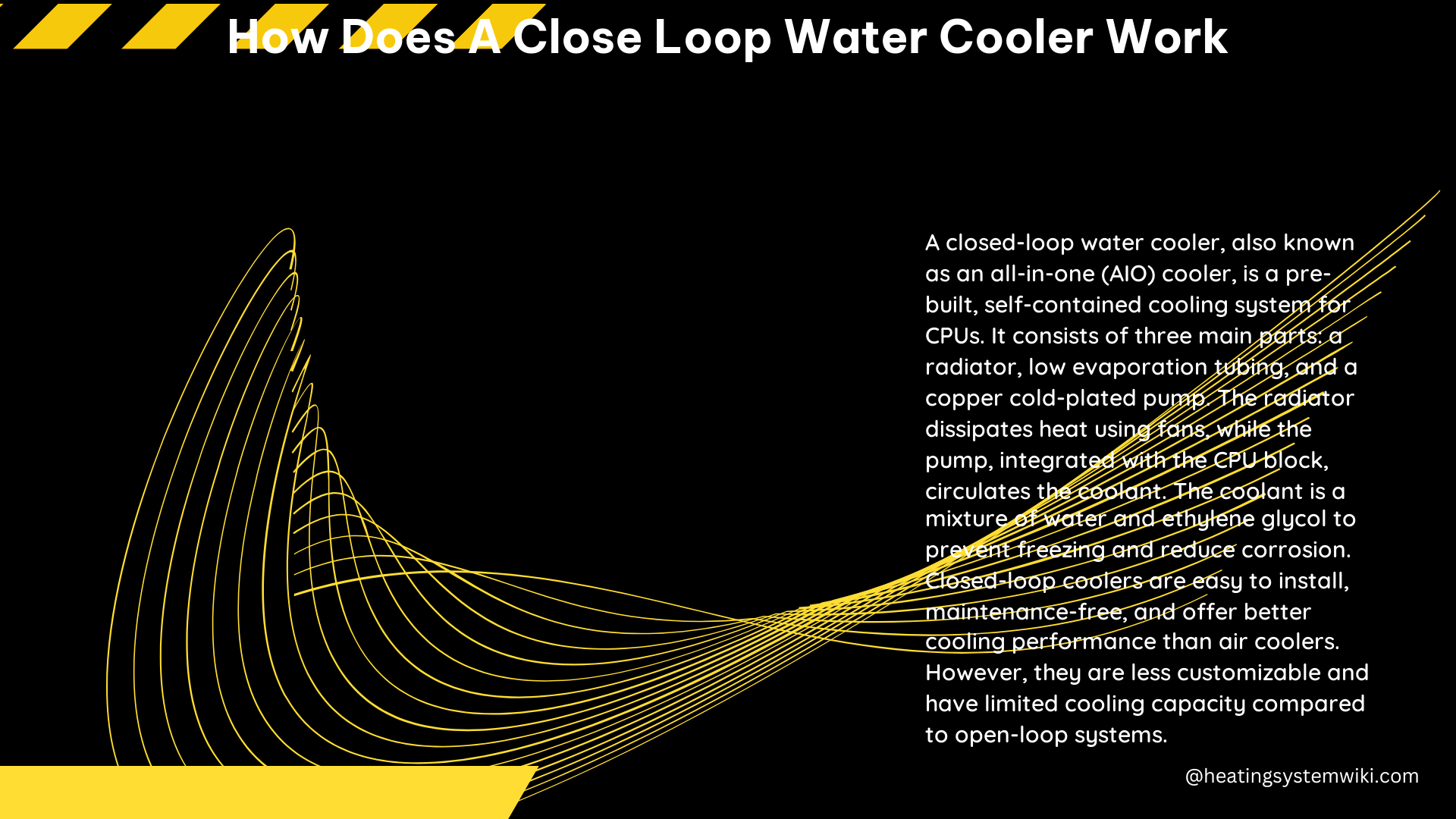A closed-loop water cooler, also known as a sealed-loop or all-in-one (AIO) cooler, is a self-contained water cooling system designed for cooling CPUs, GPUs, or other components. It consists of a water block, a radiator, a pump, and coolant-filled tubing. The water block is mounted on the component to be cooled, while the radiator is mounted in the computer case with fans to dissipate the heat. The pump circulates the coolant between the water block and the radiator to absorb and remove heat from the component.
Understanding the Components of a Closed-Loop Water Cooler
-
Water Block: The water block is the component that directly contacts the heat-generating component, such as a CPU or GPU. It is typically made of copper or aluminum and has a flat surface that makes direct contact with the component’s heat spreader. The water block contains internal channels that allow the coolant to flow through and absorb the heat.
-
Radiator: The radiator is the component responsible for dissipating the heat absorbed by the coolant. It is typically made of aluminum or copper and has a series of thin fins that increase the surface area for heat dissipation. Fans are mounted on the radiator to blow air across the fins, effectively removing the heat from the system.
-
Pump: The pump is the heart of the closed-loop water cooler, responsible for circulating the coolant through the system. It is typically a small, low-profile pump that is integrated into the water block or the radiator assembly. The pump’s performance, measured in liters per minute (LPM) or gallons per minute (GPM), is a crucial factor in determining the overall cooling capacity of the system.
-
Coolant: The coolant used in a closed-loop water cooler is a mixture of water and anti-freeze/anti-corrosion additives. These additives help prevent scale build-up, freeze damage, and corrosion of the system components. The coolant is sealed within the system and does not require refilling or maintenance, making it a low-maintenance cooling solution.
-
Tubing: The tubing in a closed-loop water cooler is typically made of flexible, durable materials such as rubber or plastic. The tubing connects the water block, radiator, and pump, allowing the coolant to circulate through the system.
Technical Specifications and Performance Factors

-
Radiator Size: Closed-loop water coolers come in a variety of radiator sizes, ranging from 120mm to 480mm. The radiator size, along with its thickness and fin density, directly affects the cooling performance of the system. Larger radiators with higher fin densities generally provide better heat dissipation.
-
Pump Performance: The pump’s flow rate, measured in LPM or GPM, is a crucial factor in determining the overall cooling capacity of the system. Higher flow rates allow for more efficient heat transfer from the water block to the radiator.
-
Coolant Composition: The coolant mixture used in closed-loop water coolers typically consists of water and anti-freeze/anti-corrosion additives. The specific composition of the coolant can affect its thermal properties, viscosity, and compatibility with the system components.
-
Compatibility: Closed-loop water coolers are designed to be compatible with specific CPU sockets and GPU models. It is essential to ensure that the cooler is compatible with the components you intend to cool to ensure proper fit and optimal performance.
-
Noise Level: Closed-loop water coolers generally produce lower noise levels compared to traditional air coolers, as the pump and fans operate at lower speeds to achieve the desired cooling performance.
Advantages and Limitations of Closed-Loop Water Coolers
Advantages:
– Improved performance and efficiency compared to air coolers
– Lower noise levels
– Aesthetically pleasing appearance
– Easier installation compared to open-loop systems
Limitations:
– Lower customization options compared to open-loop systems
– Limited cooling capacity for high-performance components
– Potential compatibility issues with certain components or cases
– Sealed nature limits the ability to upgrade or modify the system
Teardown and Inner Workings
To better understand the inner workings of a closed-loop water cooler, we can refer to a teardown video of a CPU liquid cooler. The video shows the various components of the cooler, including the water block, pump, radiator, and coolant.
The water block contains a copper cold plate that makes direct contact with the CPU’s heat spreader. The pump, which is often integrated into the water block or radiator assembly, circulates the coolant through the system. The radiator, with its fins and fans, dissipates the heat absorbed by the coolant.
The coolant itself is a mixture of water and additives, such as anti-freeze and anti-corrosion agents, to prevent scale build-up, freeze damage, and corrosion of the system components.
Conclusion
A closed-loop water cooler is a self-contained water cooling system that offers improved performance and efficiency compared to traditional air coolers. It consists of a water block, radiator, pump, and coolant-filled tubing, all sealed within the system. The technical specifications, such as radiator size, pump performance, and coolant composition, play a crucial role in determining the overall cooling capacity and performance of the system.
While closed-loop water coolers provide a more aesthetically pleasing and lower-maintenance cooling solution, they may have some limitations in terms of customization options and compatibility with certain components or cases. Understanding the inner workings and technical details of a closed-loop water cooler can help users make informed decisions when selecting and installing the right cooling solution for their needs.
References:
– The Importance of Closed-Loop Water Systems | Chardon Labs
– What’s Inside a CPU Liquid Cooler (Closed Loop) Teardown
– What is an open loop and closed loop? – watercooling – Reddit
– Closed loop Vs Open Loop Water Cooling – UK Gaming Computers
– Technical Deep-Dive: Closed-Loop Liquid Cooling – YouTube
